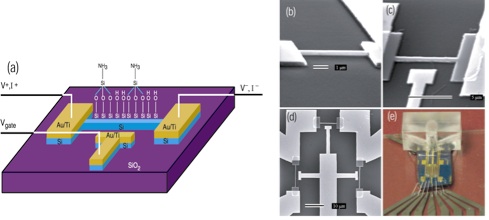N a n o s e n s o r s

Nanoelectronic sensors,
smaller than one of the 1 billion
devices in the current Intel
microprocesser chip, because
of their small size and large
surface-to-volume ratio, enable
innovative measurements of the
surface charge profile. Using these
nano-channel devices, we have been
able to detect hydrogen ions (pH),
glucose, protein and—-more importantly, cancer-specific biomarkers at a level relevant for clinical use.


Ultrasensitive detection of biological and chemical species is fundamental to the screening and detection of disease, discovery and screening of drugs. In particular, the ability to detect ions in liquid solutions with ion-selective nanoscale electronic sensors is important to the detection of proteins, virus and DNA. We are pursuing two distinct approaches for developing nanoscale biosensors for ultrasensitive detection of disease-specific proteins. The first approach involves the development of a BIOFET device in which the presence of proteins is detected by a corresponding change in the conductance of a bio-functionalized silicon nanowire. The second approach focuses on developing functionalized sub-micron mechanical sensors in which the presence of specific biomolecules is detected by a corresponding change in the displacement or a shift in the resonance frequency.
Recently we have demonstrated the operation of a nanoscale field-effect pH sensor engineered from a functionalized silicon nanowire. With this nanofabricated pH sensor, the change in the hydrogen ion concentration can be detected by the corresponding change in the nanowire differential conductance with a resolution of 5 nS/pH. Fabrication of selective side gates on the nanowire sensor allows field-effect control of the surface charge on the nanowire by modifying the accumulation of charge carriers. Nanoelectronic sensors with physically engineered gates offer the possibility of highly parallel labeling and detection of biological molecules with selective control of individual array elements.


Read more ...
-
•Nanosensors for Breast Cancer Diagnosis, P. Mohanty, Y. Chen, X. Wang, M. K. Hong, C. L. Rosenberg, D. T. Weaver and S. Erramilli, Invited Review on Cancer Biosensors, edited by K. H. Herold and A. Rasooly (CRC Press, 2011)
-
•Nanoelectronic detection of breast cancer biomarker, Y. Chen, X. Wang, M. K. Hong, C. L. Rosenberg, B. M. Reinhard, S. Erramilli and P. Mohanty, Appl. Phys. Lett., 97, 233702 (2010)
-
•Silicon-based Nanochannel Glucose Sensor, X. Wang, Yu Chen, Katherine A. Gibney, Shyamsunder Erramilli, and Pritiraj Mohanty Appl. Phys. Lett. 92, 013903 (2008).
-
•Nanoscale Field Effect Transistors for Biomolecular Signal Amplification, Yu Chen, Xihua Wang, Mi K. Hong, Shyamsunder Erramilli, Pritiraj Mohanty, and Carol Rosenberg Appl. Phys. Lett. 91, 243511 (2007).
-
•Dynamical Response of Nanomechanical Oscillators in Immiscible Viscous Fluid for in vitro Biomolecular Recognition, Jerome Dorignac, Agnieszka Kalinowski, Shyamsunder Erramilli, and Pritiraj Mohanty Phys. Rev. Lett. 96, 186105 (2006).


